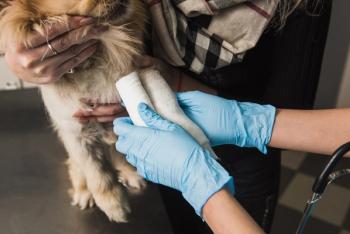
Three important updates in veterinary emergency and critical care
Fluid therapy debates, ultrasound advancements and a Fear-Free tip from critical care specialist Garret Pachtinger.
Getty ImagesRecently Garret Pachtinger, VMD, DACVECC, a criticalist with Veterinary Specialty and Emergency Center in Levittown, Pennsylvania, and a partner with
1. Fluid therapy
For years, Pachtinger says, veterinary and human health researchers have been studying crystalloids vs. colloids-what gets the patient better, what's least expensive, what carries the least risks?
The debate centers particularly on the use of synthetic colloids. In human medicine, there's concern about the risk of kidney failure associated with certain procedures such as cardiac bypass, Pachtinger says-in fact, some other countries place a black box warning on synthetic colloids detailing these risks.
Dr. Garret PachtingerPachtinger says a great deal of research is currently being conducted on the risks and benefits of synthetic colloid use in veterinary medicine, and in the next few years the profession may receive some clear guidance based on the findings. In the meantime, Pachtinger says, he will continue to use synthetic colloids in practice.
“I don't know what my argument will be in five years,” he told dvm360. “What I know right now is the benefits outweigh the risks.”
2. Use of ultrasound
With ultrasound becoming more affordable for many practices, Pachtinger predicts increased use in general practice, especially in trauma situations. “With ultrasound, people used to feel like they had to be trained like radiologists to use it,” he says. “But I'm not a trained radiologist and I use ultrasound in practice.”
In the last several years, he says, several protocols have been established that allow practitioners to to take a highly systematic approach to using ultrasound, especially in trauma cases. Of particular note is the FAST protocol-focused assessment with sonography for trauma-which has evolved to encompass triage and tracking and is now referred to as the FAST3 protocol. (See
“Ultrasound is something more and more practitioners are getting and using in a systematic and qualified way, not only to diagnose but also to evaluate, track and treat,” Pachtinger says.
3. Fear-Free experience
Emergency medicine can be a challenging and stressful environment, not only for the patient but also for the pet owner, Pachtinger says. He offers one idea for alleviating some of this stress.
“We all understand that certain emergencies are not true emergencies, but they are emergencies to that pet parent,” Pachtinger says. What often happens in that situation? The pet is taken to the triage area, determined to be relatively stable and left in triage while the doctor attends to more urgent patients. When the doctor has a break, he or she finally circles back around to the owners with an explanation.
But in the meantime, the pet parents are clueless-and probably worried. “In these situations, reunite the pet and owner in the waiting area or an exam room until you can come discuss what's going on with the patient,” Pachtinger suggests.
“The bottom line is that for a less fearful experience, as long as the patient is stable, reunite it with the owners. There's less stress for everybody involved,” he says.
Newsletter
From exam room tips to practice management insights, get trusted veterinary news delivered straight to your inbox—subscribe to dvm360.





